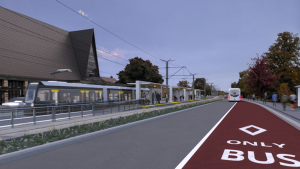The Region of Waterloo is moving forward with a phased integration approach to developing the King-Victoria Transit Hub (KVTH), an integrated, mixed-use, transit-oriented development in Kitchener, Ont.
A Request for Qualifications (RFQ) process for a master developer generated one qualified submission from KVTH Partners Inc., a consortium of Ellis Don Capital, Kilmer Group and Perimeter Development Corp. A request for proposals (RFP) for purchase by negotiation with KVTH Partners was terminated in November.
“We made the decision to move forward with a standard RFP process but knowing that we were only dealing with one proponent because the RFQ only resulted in one and it was for purchase by negotiation,” explained Ellen McGaghey, project director, King-Victoria Transit Hub, Region of Waterloo.
“As we worked our way through the process it became clear that there wasn’t a lot of advantage to doing it that way so we mutually agreed to end the process and go ahead with this phased approach. Essentially, it’s going to end up being phased anyway so we would take control of building the transit infrastructure and look at other partnerships down the road for the private components of the site.”
Staff considered a number of criteria before making the decision and ultimately decided phased integration was the preferred option to meet the schedule requirements and overall goals of the project, McGaghey noted. The new hub will be located on a four-acre brownfield site owned by the region near the intersection of King and Victoria streets in Kitchener. The provincial government contributed $43 million to the project last June.
Under the phased approach, the region can build the transit infrastructure immediately through a conventional procurement, indicates a March staff report, adding future phases would involve partnerships with private developers to complete the project.
The project is currently in the design stage which should be complete and ready to tender in the first half of 2020. A49 and WZMH Architects have been retained to provide preliminary design concepts. They were also the consulting team for the RFP process.
Construction of the transit infrastructure is expected to begin in 2020 and be completed by the end of 2021 or early 2022.
“Essentially, the design we had previously was just an indicative design that provided guidance to potential developers as to what our transit requirements were for the site. Now we need to dissect that and just build the transit infrastructure for it,” said McGaghey.
“We know what the pieces are but how that will go together and how the architects will magic that into a piece of beautiful architecture is the piece we need to sort out now.”
The site also includes a historic Rumpel Felt building at Duke and Victoria streets. The historic elements of the building will either be incorporated into the transit infrastructure or into future private development on the site, McGaghey said.
The Region identified three primary goals for the transit hub: to provide a centralized transportation facility with infrastructure that delivers seamless connections between walking, cycling, ION LRT, inter-city bus services, GO and VIA Rail service, as well as Grand River Transit buses; develop a high-density, transit-oriented development with residential, office and retail uses, fully integrated with the proposed transit-related infrastructure; and leverage the development of the entire Transit Hub site to reduce the Region’s overall infrastructure costs.
“Certainly, there is lots of interest in terms of doing residential development on the site as well as office development because this will be the prime connection to the Toronto market on the Region of Waterloo-Toronto Innovation Corridor,” said McGaghey.
While the region is not sure exactly what they station will look like they know what the functional components will be.
There will be passenger pick and drop off, bus bays, bus lay-bys, a transit hall and the Metrolinx standard platforms and canopies because the Metrolinx station will be moving from its current location to the new site.
Taxis, car sharing, pedestrians and cyclists will also be integrated into the plan as well as links to trails and paths.
“It’s very much a piece of city building and about urbanizing that area,” said McGaghey.
“This is a pretty significant piece of real estate in the Region of Waterloo as well as in downtown Kitchener so making sure that it makes the right statement that says ‘when you’ve arrived here, you’ve arrived in the Region of Waterloo.’ I think its more about that feel, about getting that right at this stage than so much about exactly how you achieve that.”











Recent Comments
comments for this post are closed